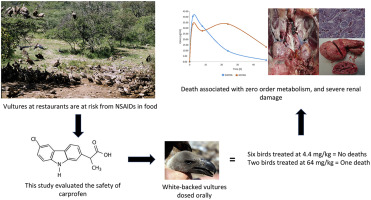当前位置:
X-MOL 学术
›
Chemosphere
›
论文详情
Our official English website, www.x-mol.net, welcomes your
feedback! (Note: you will need to create a separate account there.)
The use of toxicokinetics and exposure studies to show that carprofen in cattle tissue could lead to secondary toxicity and death in wild vultures
Chemosphere ( IF 8.1 ) Pub Date : 2017-09-14 , DOI: 10.1016/j.chemosphere.2017.08.167 V. Naidoo , M.A. Taggart , N. Duncan , K. Wolter , J. Chipangura , R.E. Green , T.H. Galligan
Chemosphere ( IF 8.1 ) Pub Date : 2017-09-14 , DOI: 10.1016/j.chemosphere.2017.08.167 V. Naidoo , M.A. Taggart , N. Duncan , K. Wolter , J. Chipangura , R.E. Green , T.H. Galligan

|
Veterinary medicines can be extremely damaging to the environment, as seen with the catastrophic declines in Gyps vulture in South Asia due to their secondary exposure to diclofenac in their primary food source. Not surprisingly, concern has been raised over other similar drugs. In this study, we evaluate the toxicity of carprofen to the Gyps vulture clade through plasma pharmacokinetics evaluations in Bos taurus cattle (their food source) and Gyps africanus (a validated model species); tissue residues in cattle; and the effect of carprofen as a secondary toxicant as both tissue-bound residue or pure drug at levels expected in cattle tissues. Carprofen residues were highest in cattle kidney (7.72 ± 2.38 mg/kg) and injection site muscle (289.05 ± 98.96 mg/kg of dimension of 5 × 5x5 cm). Vultures exposed to carprofen as residues in the kidney tissue or pure drug equivalents showed no toxic signs. When exposed to average injection site concentrations (64 mg/kg) one of two birds died with evidence of severe renal and liver damage. Toxicokinetic analysis revealed a prolonged drug half-life of 37.75 h in the dead bird as opposed to 13.99 ± 5.61 h from healthy birds dosed intravenously at 5 mg/kg. While carprofen may generally be harmless to Gyps vultures, its high levels at the injection site in treated cattle can result in lethal exposure in foraging vultures, due to relative small area of tissue it is found therein. We thus suggest that carprofen not be used in domesticated ungulates in areas where carcasses are accessible or provided to vultures at supplementary feeding sites.
中文翻译:

使用毒物动力学和接触研究表明,牛组织中的卡洛芬可能导致野性秃鹰继发毒性和死亡
兽医药物可能对环境造成极大破坏,南亚的吉普斯秃鹰(Gyps)秃鹰由于其主要食物来源中二次接触双氯芬酸而遭受了灾难性的减少,这可以看出这一点。毫不奇怪,已经引起了对其他类似药物的关注。在这项研究中,我们评估卡洛芬到的毒性兀通过血浆中药物动力学评估秃鹫分支普通牛的牛(它们的食物源)和高山兀非洲种(经过验证的模型物种);牛的组织残留;以及卡洛芬作为次要毒物的作用,无论是组织结合的残留物还是纯药物,都在牛组织中达到预期水平。卡洛芬残留量最高的是牛肾(7.72±2.38 mg / kg)和注射部位肌肉(289.05±98.96 mg / kg,尺寸为5×5x5 cm)。作为肾组织中残留的卡洛芬或纯药物等效物暴露的秃pure没有毒性迹象。当暴露于平均注射部位浓度(64 mg / kg)时,两只鸟中的一只死亡,并伴有严重的肾脏和肝脏损害。毒代动力学分析显示,死鸟的药物半衰期延长,为37.75小时,而以5 mg / kg静脉注射的健康鸟的药物半衰期为13.99±5.61小时。虽然卡洛芬通常可能对吉普斯无害秃ul,在治疗过的牛的注射部位,其高水平会导致觅食秃let的致死性接触,因为在其中发现的组织面积相对较小。因此,我们建议在可接近或向补充饲养场所的秃provided提供areas体的区域中,不要将咔洛芬用于驯养的有蹄类动物。
更新日期:2017-09-14
中文翻译:

使用毒物动力学和接触研究表明,牛组织中的卡洛芬可能导致野性秃鹰继发毒性和死亡
兽医药物可能对环境造成极大破坏,南亚的吉普斯秃鹰(Gyps)秃鹰由于其主要食物来源中二次接触双氯芬酸而遭受了灾难性的减少,这可以看出这一点。毫不奇怪,已经引起了对其他类似药物的关注。在这项研究中,我们评估卡洛芬到的毒性兀通过血浆中药物动力学评估秃鹫分支普通牛的牛(它们的食物源)和高山兀非洲种(经过验证的模型物种);牛的组织残留;以及卡洛芬作为次要毒物的作用,无论是组织结合的残留物还是纯药物,都在牛组织中达到预期水平。卡洛芬残留量最高的是牛肾(7.72±2.38 mg / kg)和注射部位肌肉(289.05±98.96 mg / kg,尺寸为5×5x5 cm)。作为肾组织中残留的卡洛芬或纯药物等效物暴露的秃pure没有毒性迹象。当暴露于平均注射部位浓度(64 mg / kg)时,两只鸟中的一只死亡,并伴有严重的肾脏和肝脏损害。毒代动力学分析显示,死鸟的药物半衰期延长,为37.75小时,而以5 mg / kg静脉注射的健康鸟的药物半衰期为13.99±5.61小时。虽然卡洛芬通常可能对吉普斯无害秃ul,在治疗过的牛的注射部位,其高水平会导致觅食秃let的致死性接触,因为在其中发现的组织面积相对较小。因此,我们建议在可接近或向补充饲养场所的秃provided提供areas体的区域中,不要将咔洛芬用于驯养的有蹄类动物。










































 京公网安备 11010802027423号
京公网安备 11010802027423号